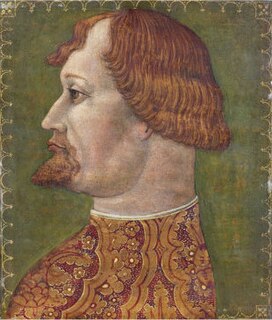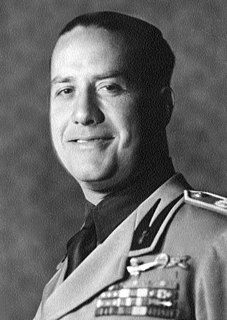
Galeazzo di Santa Sofia (died 1427) was an Italian physician and anatomist.

Galeazzo di Santa Sofia (died 1427) was an Italian physician and anatomist.
He taught medicine at the universities in Bologna and Padua. He was called to Vienna where he introduced anatomy as a subject of study and in 1404 made the first dissection north of the Alps. [1]

Galeazzo Alessi was an Italian architect from Perugia, known throughout Europe for his distinctive style based on his enthusiasm for ancient architecture. He studied drawing for civil and military architecture under the direction of Giovanni Battista Caporali.

Sforza was a ruling family of Renaissance Italy, based in Milan. They acquired the Duchy of Milan following the extinction of the Visconti family in the mid-15th century, Sforza rule ending in Milan with the death of the last member of the family's main branch in 1535.

Gian Galeazzo Visconti, was the first duke of Milan (1395) and ruled the late-medieval city just before the dawn of the Renaissance. He was the founding patron of the Certosa di Pavia, completing the Visconti Castle at Pavia begun by his father and furthering work on the Duomo of Milan.

Gian Galeazzo Ciano, 2nd Count of Cortellazzo and Buccari was an Italian diplomat and politician who served as Foreign Minister in the government of his father-in-law, Benito Mussolini, from 1936 until 1943. During this period, he was widely seen as Mussolini's most probable successor as head of government.

Galeazzo II Visconti was a member of the Visconti dynasty and a ruler of Milan, Italy.

The Visconti of Milan are a noble Italian family. They rose to power in Milan during the Middle Ages where they ruled from 1277 to 1447, initially as lords then as dukes, and several collateral branches still exist. The effective founder of the Visconti lordship of Milan was the archbishop Ottone, who wrested control of the city from the rival Della Torre family in 1277.

The Duchy of Milan was a state in northern Italy, created in 1395 by Gian Galeazzo Visconti, then the lord of Milan, and a member of the important Visconti family, that had been ruling the city since 1277.

Galeazzo Maria Sforza was the fifth Duke of Milan from 1466 until his assassination a decade later. He was notorious for being lustful, cruel and tyrannical.

Girolamo Francesco Maria Mazzola, also known as Francesco Mazzola or, more commonly, as Parmigianino, was an Italian Mannerist painter and printmaker active in Florence, Rome, Bologna, and his native city of Parma. His work is characterized by a "refined sensuality" and often elongation of forms and includes Vision of Saint Jerome (1527) and the iconic if somewhat anomalous Madonna with the Long Neck (1534), and he remains the best known artist of the first generation whose whole careers fall into the Mannerist period.

Abbiategrasso, formerly written Abbiate Grasso, is a comune and town in the Metropolitan City of Milan, Lombardy, northern Italy, situated in the Po valley approximately 22 kilometres from Milan and 38 kilometres from Pavia.

Gian Galeazzo Sforza, also known as Giovan Galeazzo Sforza, was the sixth Duke of Milan.
The following are the association football events of the year 1948 throughout the world.

The National Central Library of Florence is a public national library in Florence, the largest in Italy and one of the most important in Europe, one of the two central libraries of Italy, along with the Biblioteca Nazionale Centrale di Roma.

Zanetto Bugatto, also known as Zanetto Bugatti, was one of the most well documented court portraitists of the 1400s. A key painter of the Lombardy region, Bugatto worked for 15 years for the first two Sforza Dukes of Milan, particularly Duke Galeazzo Maria Sforza and his Duchess Bona of Savoy. His work was influenced by artists such as Rogier van der Weyden, Andrea Mantegna, and Jean Fouquet, all of whom he met during his travels. Bugatto's work was described by Galeazzo's ambassador Leonardo Botta as being similar to Sicilian painter Antonello da Messina. It is not clear whether Bugatto painted works other than portraits which he typically made on panel and in fresco. He is notable for being one of the first Italian artists, along with Antonello da Messina, to focus on portraiture in the Netherlandish style to such an exclusive extent.

Fear and Sand is a 1948 Italian comedy film directed by Mario Mattoli and starring Totò.

Galeazzo Marescotti was an Italian cardinal.

Io e mia sorella is a 1987 Italian romantic comedy-drama film written, directed and starred by Carlo Verdone. For this film Elena Sofia Ricci was awarded with a David di Donatello for Best Supporting Actress and a Silver Ribbon in the same category. The film also won a Silver Ribbon for best actress and a David di Donatello for Best Script.

Adriaen van Bloemen or Adriaen Bloem was a Flemish painter, print designer, draughtsman and engraver. He was mainly a portrait artist who created individual and group portraits. He left his native Antwerp to work in Vienna where he became court painter to Emperor Leopold I. His work is mainly known through the prints made after it by various engravers.

Luca Spinola was the 57th Doge of the Republic of Genoa.